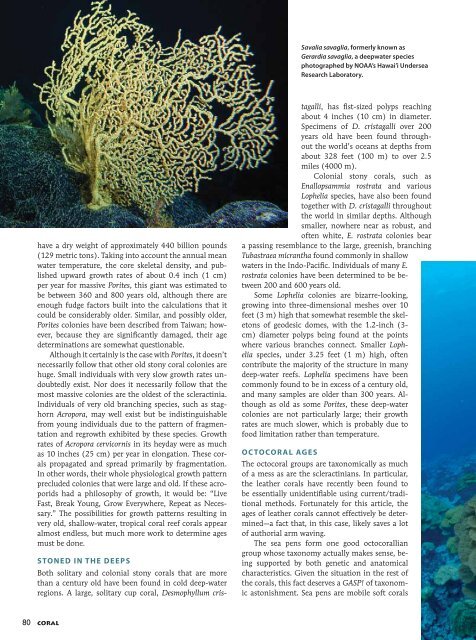You also want an ePaper? Increase the reach of your titles
YUMPU automatically turns print PDFs into web optimized ePapers that Google loves.
Savalia savaglia, formerly known as<br />
Gerardia savaglia, a deepwater species<br />
photographed by NOAA’s Hawai’i Undersea<br />
Research Laboratory.<br />
have a dry weight of approximately 440 billion pounds<br />
(129 metric tons). Taking into account the annual mean<br />
water temperature, the core skeletal density, and published<br />
upward growth rates of about 0.4 inch (1 cm)<br />
per year for massive Porites, this giant was estimated to<br />
be between 360 and 800 years old, although there are<br />
enough fudge factors built into the calculations that it<br />
could be considerably older. Similar, and possibly older,<br />
Porites colonies have been described from Taiwan; however,<br />
because they are significantly damaged, their age<br />
determinations are somewhat questionable.<br />
Although it certainly is the case with Porites, it doesn’t<br />
necessarily follow that other old stony coral colonies are<br />
huge. Small individuals with very slow growth rates undoubtedly<br />
exist. Nor does it necessarily follow that the<br />
most massive colonies are the oldest of the scleractinia.<br />
Individuals of very old branching species, such as staghorn<br />
Acropora, may well exist but be indistinguishable<br />
from young individuals due to the pattern of fragmentation<br />
and regrowth exhibited by these species. Growth<br />
rates of Acropora cervicornis in its heyday were as much<br />
as 10 inches (25 cm) per year in elongation. These corals<br />
propagated and spread primarily by fragmentation.<br />
In other words, their whole physiological growth pattern<br />
precluded colonies that were large and old. If these acroporids<br />
had a philosophy of growth, it would be: “Live<br />
Fast, Break Young, Grow Everywhere, Repeat as Necessary.”<br />
The possibilities for growth patterns resulting in<br />
very old, shallow-water, tropical coral reef corals appear<br />
almost endless, but much more work to determine ages<br />
must be done.<br />
STONED IN THE DEEPS<br />
Both solitary and colonial stony corals that are more<br />
than a century old have been found in cold deep-water<br />
regions. A large, solitary cup coral, Desmophyllum cristagalli,<br />
has fist-sized polyps reaching<br />
about 4 inches (10 cm) in diameter.<br />
Specimens of D. cristagalli over 200<br />
years old have been found throughout<br />
the world’s oceans at depths from<br />
about 328 feet (100 m) to over 2.5<br />
miles (4000 m).<br />
Colonial stony corals, such as<br />
Enallopsammia rostrata and various<br />
Lophelia species, have also been found<br />
together with D. cristagalli throughout<br />
the world in similar depths. Although<br />
smaller, nowhere near as robust, and<br />
often white, E. rostrata colonies bear<br />
a passing resemblance to the large, greenish, branching<br />
Tubastraea micrantha found commonly in shallow<br />
waters in the Indo-Pacific. Individuals of many E.<br />
rostrata colonies have been determined to be between<br />
200 and 600 years old.<br />
Some Lophelia colonies are bizarre-looking,<br />
growing into three-dimensional meshes over 10<br />
feet (3 m) high that somewhat resemble the skeletons<br />
of geodesic domes, with the 1.2-inch (3-<br />
cm) diameter polyps being found at the points<br />
where various branches connect. Smaller Lophelia<br />
species, under 3.25 feet (1 m) high, often<br />
contribute the majority of the structure in many<br />
deep-water reefs. Lophelia specimens have been<br />
commonly found to be in excess of a century old,<br />
and many samples are older than 300 years. Although<br />
as old as some Porites, these deep-water<br />
colonies are not particularly large; their growth<br />
rates are much slower, which is probably due to<br />
food limitation rather than temperature.<br />
OCTOCORAL AGES<br />
The octocoral groups are taxonomically as much<br />
of a mess as are the scleractinians. In particular,<br />
the leather corals have recently been found to<br />
be essentially unidentifiable using current/traditional<br />
methods. Fortunately for this article, the<br />
ages of leather corals cannot effectively be determined—a<br />
fact that, in this case, likely saves a lot<br />
of authorial arm waving.<br />
The sea pens form one good octocorallian<br />
group whose taxonomy actually makes sense, being<br />
supported by both genetic and anatomical<br />
characteristics. Given the situation in the rest of<br />
the corals, this fact deserves a GASP! of taxonomic<br />
astonishment. Sea pens are mobile soft corals<br />
LEFT: HURL WWW.SOEST.HAWAII.EDU/HURL/ RIGHT: BRIAN J. SKERRY/NATIONAL GEOGRAPHIC STOCK<br />
80 CORAL

















